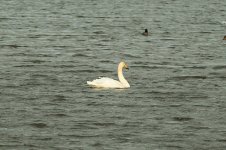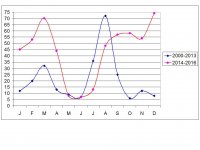UW82
Well-known member
Dave H sent me this that he had come across at the Worcester Library in the 'hive' section. BDave
Some Birds of Upton Warren
1939-1943
By J.A.Martin
A stretch of water of about ten acres has proved to be very
attractive, no doubt owing to its medium to shallow depth, and
plenty of cover provided by rushes, iris, etc. During the five
years the pool has been watched, the most noticeable feature has
been the steady increase in numbers of Teal, Shoveler, Pochard and Wigeon and the appearance of Common Scoter, Garganey and Pintail in 1943.
The formation of the pool is interesting; for many years
several meadows were subject to flooding and as a result, land
drains were laid, and with the help of these the water subsided
in about a fortnight. Owing to a stoppage in these drains and
heavy rains in 1935, the water remained, and when the rainfall
is very excessive the Salwarpe, which runs close by, overflows
its banks and feeds the pool. An interesting feature is the
line of willows whidi crosses the pool from east to west; these
once divided the meadows.
MUTE SWAN. Resident. Successfully nested in 1939-40-43.Seventeen were present on January 31st 1942.
CANADA GOOSE. An occasional visitor in small numbers. These are probably from Hewell Grange or Westwood Park.
MALLARD. Resident. The numbers vary from week to week the most seen at one time being thirty five. At least one pair nests
successfully each year as they find the willows that cross the
pool provide secure nesting sites. A brood of fifteen seen on June 8th 1943.
TEAL. Chiefly a winter visitor, although they have been seen in all months; usually arrives during the latter part of August and leaves in April or early May. The largest number noted were
Fiftyseven on December 5th 1942. One chased by a Lesser Blackbacked gull on April 14th 1940.
WIGEON. Irregular Spring and Autumn visitor in small numbers,
sometimes staying until end of the year. A pair on May 25th,
1941. The largest number being twenty on November 27th, 1943.
SHOVELER. This species has always been one of the outstanding
features of the pool. Usually present from August to May. Has been seen in all months. Sometimes present by the end of July or it may be early October before any are seen. A pair stayed until June 11th 1942. The largest number noted were thirty on December 5th 1942 and twentyeight on Nov.6th 1943; both occasions being after heavy rain the preceeding day and night.
POCHARD. A common winter visitor unusual in summer but has been seen in all months. Arrive end of August in small numbers and larger winter flocks by October. Males usually predominate.The maximum number seen were eightyfive on Nov.6th 1943» and
fiftyseven on Nov.7th 1942
TUFTED DUCK. Chiefly a Spring and Autumn visitor in small numbers. The largest number recorded is fourteen on April 2nd,
1942. Present in 1943 from January onwards when three pairs
stayed until June 8th and from then on two pairs remained; one
of these pairs nested and a brood of three was seen on August 8th,
but only two were reared. This is the fourth nesting record for Wores.
GARGANEY. A pair on April 11th 1943.
PINTAIL. A female on Oct.3rd.1943 four males and two females on Dec.4th 1943.
COMMON SCOTER. A female on April 18th and August 8-10th 1943.
GREAT CRESTED GREBE. Regular Spring visitor in small numbers. One pair with three young seen by P.Pincher on Aug.7th 1938 Other attempts to nest in recent years not successful. Usually arrive mid-March and leave in June. Largest number twelve on May 11th 1939.
LITTLE GREBE. Summer visitor from March to October, although two stayed until the end of 1943. Up to four pairs breed annually.
The gradual building up of numbers during the Autumn migration is very marked thirtyfive being the most recorded.
MOORHEN. Resident. Up to sixty birds have been noted in Winter.
COOT. Resident and Winter visitor. Their numbers often approach two hundred in the winter months. About twenty pairs breed but most of their eggs are taken.
UPTON WARREN BROMSGROVE
Mr.A.J.Martin has noted the following birds on a pool of about two acres extent, situated at Upton Warren.
Hobby. Seen attacking a flock of Swifts and Swallows on May 22. Wigeon. A pair on May 25. Shoveller. A drake on May 22 and a pair on Sept.3. Redshank. Frequently seen during April until end of June. Dunlin. A single bird April 23-30. Common Sandpiper. Seen twice during last week in April and on four occasions in early May. Green Sandpiper. Two birds on April 16 and again on July 30. A single bird on Aug.12 and 24. Black Tern. One on April 23. "Its head, neck and breast were very dark; the rest of the upper-parts slate grey; its white undertail cosrerts were very noticeable in flight. The tail was short and only slightly forked, the bill appeared to be black; the colour of its legs could not be seen. The bird spent most of the time flying round against a stiff east wind, but was seen to dive and pick up food from the surface of the water on at least two occasions". Black-necked Grebe. A single bird on April 10. "It was larger than the Little Grebe, sat higher in the water, and its white underparts contrasted with the black upperparts very conspicuously. I was puzzled by the bill but can now assume that it was uptilted in the charactaristic fashion of this species." Little Grebe. Four
pairs bred. Great-crested Grebe. Seen between March 15th and June 26, the greatest number being six on May 19. Canada Goose. See on May 10, June 4, and Aug.12. Lesser Black-backed Gull. Single birds on March 29 and April 30.
Fascinating reading John. Most of the information is not found in the Birds of Worcestershire , published in the 1940's, which Martin must have contributed to. A number of Martin's records are in the old WMBC reports, however.
Des.






